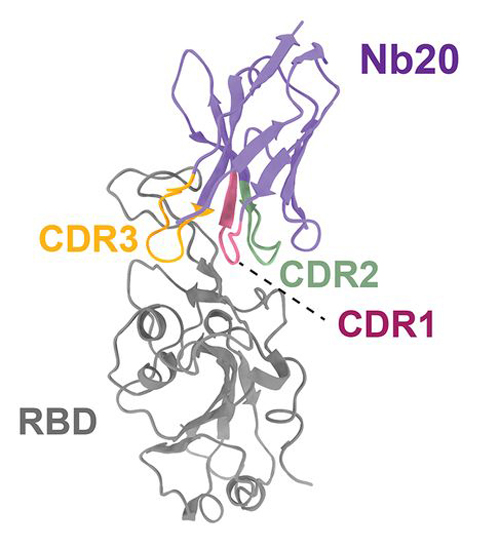
Since the start of the COVID-19 outbreak, scientists from around the world have been working to learn more about the structure of the virus that causes the disease. One of the most powerful tools to illuminate the structure of the SARS-CoV-2 virus has been the Advanced Photon Source (APS), a U.S. Department of Energy (DOE) Office of Science User Facility at DOE’s Argonne National Laboratory.
Scientists use the powerful X-rays generated by the APS to determine the exact atomic arrangement of the virus’s proteins, either alone or with compounds and antibodies that may be used for treatment. Each of these structures is then deposited into the international Protein Data Bank, with contributions from the world scientific community. These structures are used by scientists around the world to develop effective vaccines and treatments.
This week, the 100th structure related to COVID-19 determined using the APS was released. The 100th structure was deposited by a research group from the University of Pittsburgh led by Assistant Professor Yi Shi, part of a study into the effectiveness of nanobodies extracted from llamas as a treatment for COVID-19. That structure (pictured) was determined at the National Institute of General Medical Sciences and National Cancer Institute structural biology facility 23-ID x-ray beamline at the U.S. Department of Energy's APS.
Scientists use the powerful X-rays generated by the APS to determine the exact atomic arrangement of the virus’s proteins, either alone or with compounds and antibodies that may be used for treatment. Each of these structures is then deposited into the international Protein Data Bank, with contributions from the world scientific community. These structures are used by scientists around the world to develop effective vaccines and treatments.
More structures of SARS-CoV-2 have been determined at the APS than at any other light source in the United States.
“Much of what we know about the SARS-CoV-2 virus comes from APS data,” said Stephen Streiffer, Argonne’s deputy laboratory director for Science and Technology and the interim director of the APS. “One hundred structures means 100 opportunities to take on this disease, and the APS will continue to be an important part of that fight with structure 101 and beyond.”
This research used resources of the Advanced Photon Source, a U.S. DOE Office of Science User Facility operated for the DOE Office of Science by Argonne National Laboratory under Contract No. DE-AC02-06CH11357.
The original Argonne press release by Andre Salles can be read here.
The Advanced Photon Source is a U.S. Department of Energy (DOE) Office of Science User Facility operated for the DOE Office of Science by Argonne National Laboratory. Additional funding for beamlines used for COVID-19 research at the APS is provided by the National Institutes of Health (NIH) and by DOE Office of Science Biological and Environmental Research. The APS operated for 10 percent more hours this year than usual to support COVID-19 research, with the additional time supported by the DOE Office of Science through the National Virtual Biotechnology Laboratory, with funding provided by the Coronavirus CARES Act.
The U. S. Department of Energy Office of Science’s Advanced Photon Source (APS) at Argonne National Laboratory is one of the world’s most productive X-ray light source facilities. The APS provides high-brightness X-ray beams to a diverse community of researchers in materials science, chemistry, condensed matter physics, the life and environmental sciences, and applied research. These X-rays are ideally suited for explorations of materials and biological structures; elemental distribution; chemical, magnetic, electronic states; and a wide range of technologically important engineering systems from batteries to fuel injector sprays, all of which are the foundations of our nation’s economic, technological, and physical well-being. Each year, more than 5,000 researchers use the APS to produce over 2,000 publications detailing impactful discoveries, and solve more vital biological protein structures than users of any other X-ray light source research facility. APS scientists and engineers innovate technology that is at the heart of advancing accelerator and light-source operations. This includes the insertion devices that produce extreme-brightness X-rays prized by researchers, lenses that focus the X-rays down to a few nanometers, instrumentation that maximizes the way the X-rays interact with samples being studied, and software that gathers and manages the massive quantity of data resulting from discovery research at the APS.
Argonne National Laboratory seeks solutions to pressing national problems in science and technology. The nation’s first national laboratory, Argonne conducts leading-edge basic and applied scientific research in virtually every scientific discipline. Argonne researchers work closely with researchers from hundreds of companies, universities, and federal, state and municipal agencies to help them solve their specific problems, advance America’s scientific leadership and prepare the nation for a better future. With employees from more than 60 nations, Argonne is managed by UChicago Argonne, LLC for the U.S. Department of Energy’s Office of Science.
The U.S. Department of Energy’s Office of Science is the single largest supporter of basic research in the physical sciences in the United States and is working to address some of the most pressing challenges of our time. For more information, visit https://energy.gov/science.
